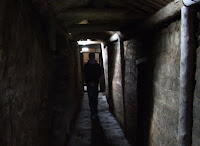Glaumbær
 This morning I visited Glaumbær, which is an old farmstead (with a church) that has been preserved like it was in the 19th century. It is now used as a museum to show how people in Iceland lived in the old days. The museum is very much worth a visit and it's admission free.
This morning I visited Glaumbær, which is an old farmstead (with a church) that has been preserved like it was in the 19th century. It is now used as a museum to show how people in Iceland lived in the old days. The museum is very much worth a visit and it's admission free. You will note, first, that the roofs were made of grass. And second, when you look closer, that the walls were made of turf, with only the fronts and, in some buildings, the insides, boarded with wood.
You will note, first, that the roofs were made of grass. And second, when you look closer, that the walls were made of turf, with only the fronts and, in some buildings, the insides, boarded with wood. Wood was rare in Iceland because there were practically no trees at all in those days. (Today they have planted lots of trees especially in and near the city areas of Reykjavik and Akureyri). In the 19th century, furniture such as chests and beds were built of driftwood that was collected at the sea shores.
Wood was rare in Iceland because there were practically no trees at all in those days. (Today they have planted lots of trees especially in and near the city areas of Reykjavik and Akureyri). In the 19th century, furniture such as chests and beds were built of driftwood that was collected at the sea shores.These buildings were quite dark inside and probably also difficult to keep dry and clean. Konrad Maurer has described these kind of buildings, which were the standard houses in Iceland up to c. 1900, in detail in his travelogue. Today these houses have completely disappeared except for a few in museums such as this one.
 This particular building is the best equipped of the ensemble, it has windows and is fully panelled inside, with a wooden floor. When you're inside you would not think that this house, on the outside, is also covered with turf and grass.
This particular building is the best equipped of the ensemble, it has windows and is fully panelled inside, with a wooden floor. When you're inside you would not think that this house, on the outside, is also covered with turf and grass. It had been the house of pastor Jón Hallsson (1807-1904).
It had been the house of pastor Jón Hallsson (1807-1904).
2 Comments:
mit Fenstern find ich diese Häuser ganz gut. Von innen sowieso, und von außen viel besser als so manche ...architektonische Verbrechen, die wären gut beraten mit einer Schicht Erde und Gras ! Gruß Ziggy
Vom Aussehen her stimme ich dir schon zu. Wirklich "naturverbundene" Architektur. Oft weideten sogar die Schafe die Daecher ab (das war willkommen, weil davon das Gras dichter wurde und man sich das Sensen sparte). Stell dir den Anblick vor! :)
An sich ist es schon schade, dass die Torfhaeuser (fast) alle verschwunden sind. Aber wohnen in so einem Torfhaus war wirklich kein Spass und ich kann es gut verstehen, dass die Islaender heute nur noch Beton- und Holzhaeuser bauen. Die sind halt doch einfach trocken, sauber, heizbar und hell innen.
Post a Comment
Subscribe to Post Comments [Atom]
<< Home